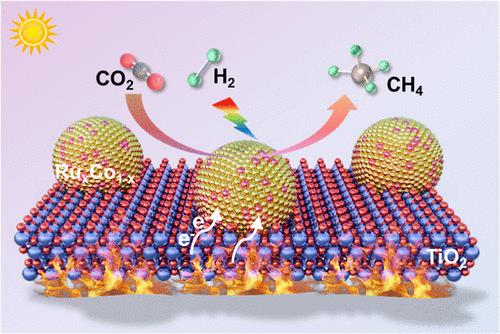Our official English website, www.x-mol.net, welcomes your feedback! (Note: you will need to create a separate account there.)
Ruthenium–Cobalt Solid-Solution Alloy Nanoparticles for Enhanced Photopromoted Thermocatalytic CO2 Hydrogenation to Methane
ACS Nano ( IF 17.1 ) Pub Date : 2024-04-21 , DOI: 10.1021/acsnano.4c02416 Yunxiang Tang 1 , Hao Wang 1 , Chan Guo 1 , Zhengyi Yang 1 , Tingting Zhao 1 , Jiurong Liu 1 , Yanyan Jiang 1, 2 , Wenlong Wang 3 , Quan Zhang 4 , Dongshuang Wu 5 , Yufei Zhao 6 , Xiao-Dong Wen 7, 8 , Fenglong Wang 1, 2
ACS Nano ( IF 17.1 ) Pub Date : 2024-04-21 , DOI: 10.1021/acsnano.4c02416 Yunxiang Tang 1 , Hao Wang 1 , Chan Guo 1 , Zhengyi Yang 1 , Tingting Zhao 1 , Jiurong Liu 1 , Yanyan Jiang 1, 2 , Wenlong Wang 3 , Quan Zhang 4 , Dongshuang Wu 5 , Yufei Zhao 6 , Xiao-Dong Wen 7, 8 , Fenglong Wang 1, 2
Affiliation

|
Bimetallic alloy nanoparticles have garnered substantial attention for diverse catalytic applications owing to their abundant active sites and tunable electronic structures, whereas the synthesis of ultrafine alloy nanoparticles with atomic-level homogeneity for bulk-state immiscible couples remains a formidable challenge. Herein, we present the synthesis of RuxCo1–x solid-solution alloy nanoparticles (ca. 2 nm) across the entire composition range, for highly efficient, durable, and selective CO2 hydrogenation to CH4 under mild conditions. Notably, Ru0.88Co0.12/TiO2 and Ru0.74Co0.26/TiO2 catalysts, with 12 and 26 atom % of Ru being substituted by Co, exhibit enhanced catalytic activity compared with the monometallic Ru/TiO2 counterparts both in dark and under light irradiation. The comprehensive experimental investigations and density functional theory calculations unveil that the electronic state of Ru is subtly modulated owing to the intimate interaction between Ru and Co in the alloy nanoparticles, and this effect results in the decline in the CO2 conversion energy barrier, thus ultimately culminating in an elevated catalytic performance relative to monometallic Ru and Co catalysts. In the photopromoted thermocatalytic process, the photoinduced charge carriers and localized photothermal effect play a pivotal role in facilitating the chemical reaction process, which accounts for the further boosted CO2 methanation performance.
中文翻译:

用于增强光促进热催化二氧化碳加氢制甲烷的钌钴固溶体合金纳米颗粒
双金属合金纳米颗粒由于其丰富的活性位点和可调节的电子结构而在各种催化应用中引起了广泛关注,而合成具有原子级均匀性的体态不混溶电偶的超细合金纳米颗粒仍然是一个艰巨的挑战。在此,我们提出了在整个成分范围内合成Ru x Co 1– x固溶体合金纳米粒子(约2 nm),以在温和条件下高效、持久和选择性地将CO 2加氢为CH 4 。值得注意的是,Ru 0.88 Co 0.12 /TiO 2和Ru 0.74 Co 0.26 /TiO 2催化剂,其中12和26原子%的Ru被Co取代,与单金属Ru/TiO 2对应物相比,在黑暗和低温下均表现出增强的催化活性。光照射。综合实验研究和密度泛函理论计算表明,由于合金纳米粒子中Ru和Co之间的紧密相互作用,Ru的电子态被微妙地调节,这种效应导致CO 2转化能垒的下降,从而最终实现相对于单金属 Ru 和 Co 催化剂,最终提高了催化性能。在光促进热催化过程中,光生载流子和局域光热效应在促进化学反应过程中发挥着关键作用,这也是进一步提高CO 2甲烷化性能的原因。
更新日期:2024-04-21
中文翻译:

用于增强光促进热催化二氧化碳加氢制甲烷的钌钴固溶体合金纳米颗粒
双金属合金纳米颗粒由于其丰富的活性位点和可调节的电子结构而在各种催化应用中引起了广泛关注,而合成具有原子级均匀性的体态不混溶电偶的超细合金纳米颗粒仍然是一个艰巨的挑战。在此,我们提出了在整个成分范围内合成Ru x Co 1– x固溶体合金纳米粒子(约2 nm),以在温和条件下高效、持久和选择性地将CO 2加氢为CH 4 。值得注意的是,Ru 0.88 Co 0.12 /TiO 2和Ru 0.74 Co 0.26 /TiO 2催化剂,其中12和26原子%的Ru被Co取代,与单金属Ru/TiO 2对应物相比,在黑暗和低温下均表现出增强的催化活性。光照射。综合实验研究和密度泛函理论计算表明,由于合金纳米粒子中Ru和Co之间的紧密相互作用,Ru的电子态被微妙地调节,这种效应导致CO 2转化能垒的下降,从而最终实现相对于单金属 Ru 和 Co 催化剂,最终提高了催化性能。在光促进热催化过程中,光生载流子和局域光热效应在促进化学反应过程中发挥着关键作用,这也是进一步提高CO 2甲烷化性能的原因。



























 京公网安备 11010802027423号
京公网安备 11010802027423号